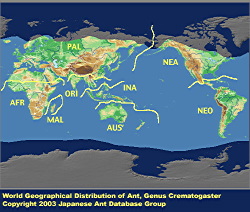
|
genus
|
Crematogaster
|
 |
Japanese Name
|
Shiriage-ari-zoku
|
Original Reference
|
|
Lund, P.W. (1831) Lettre sur les habitudes de quelques fourmis du Brsil, adresse M. Audouin. Annales des Sciences Naturelles 23: 113-138.
|
Synonym
|
|
Acrocoelia Mayr, 1853,
Tranopeltoides Wheeler, W. M., 1922,
|
Description
|
|
Workers of small to medium size. Head subrectangular or oval, sides usually convex. Mandibles small, somewhat covered by clypeus; masticatory margin with 3 - 5 denticles. Palpal formula 5:3, rarely 4:3. Anterior clypeal margin straight or widely curved and convex. Frontal carinae short. Antennae 11- or rarely 10-segmented; club lacking, or with 2 - 4 segments. Eyes of medium size, situated at or just behind the midlength of the sides of the head. Mesosoma short. Metanotal groove distinct. Propodeal spines varying from absent to long and acute. Petiole flat ventrodorsally, without node. Posterior portion of postpetiole connected to dorsum of gaster. Gaster triangular in lateral view.
|
|

|
Remarks
|
|
Crematogaster is distributed world-wide. It is a very large genus, containing approximately 400 described species. Many of which are found in warm regions. Species-level classification has been subject to little analysis. The North American species were studied by Buren (1958, 1968). These ants construct silk nests on trees, or nest within hollow plant tissues, bamboo stems, under stones or in the soil. When disturbed they proffer defensive chemicals at the gastral apex by directing it forwards above the mesosoma. Santschi's (1930) coverage of the Japanese fauna is more-or-less reliable except for his use of infraspecific categories (Onoyama, 1976). Onoyama (1998) revised four species of subgenus Crematogaster s. str., and Terayama (1999) described a new species of subgenus Orthocrema. Seven species are treated here, with 5 assigned to subgenus Crematogaster s. str. (1 nomenclaturally undetermined) and 2 to subgenus Orthocrema.
|
References
|
|
- Mayr, G. 1853. Einige neue Ameisen. Verh. Zool. Bot. Ver. Wien, 2: 143-150.
- Wheeler, W. M. 1922. Neotropical ants of the genera Carebara, Tranopelta and Tranopeltoides, new genus. Am. Mus. Novit., 48: 1-14.
- Buren, W. F. (1958). A review of the species of Crematogaster, sensu stricto, in North America (Hymenoptera: Formicidae) Part I. . J. New York. Ent. Soc., 66, 119-134.
- Buren, W. F. (1968). A review of the species of Crematogaster, sensu stricto, in North America (Hymenoptera: Formicidae) Part II. Descriptions of new species. . J. Georgia Ent. Soc., 3, 91-121.
- Santschi, F. (1930). Trois notes myrmecologiques. . Bull. Ann. Soc. Ent. Belg., 70, 263-270.
- Onoyama, K. (1976). A preliminary study of the ant fauna of Okinawa-Ken, with taxonomic notes. (Japan: Hymenoptera: Formicidae). . Ecol. Stud. Nat. Cons. Ryukyu Isl., 2, 121-141.
- Onoyama, K. (1998). Taxonomic notes on the ant genus Crematogaster in Japan (Hymenoptera: Formicidae). 1: 227-232.
- Terayama, M. (1999). Description and record of a new and a little known ants from Japan (Formicidae). In Yamane, Sk., S. Ikudome & M. Terayama, "Identification guide to the Aculeata of the Nansei Islands, Japan", pp. 726-727. Hokkaido University Press, Sapporo.
|
Editor
|
|
Original text by Keiichi Onoyama and Masaaki Morisita. English translation by Keiichi Onoyama, edited by Robert W. Taylor. Revised by Masashi Yoshimura.
|
|